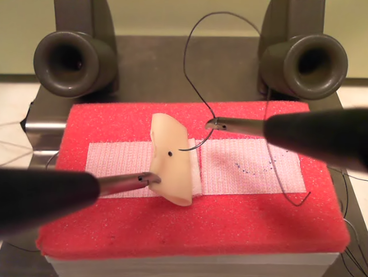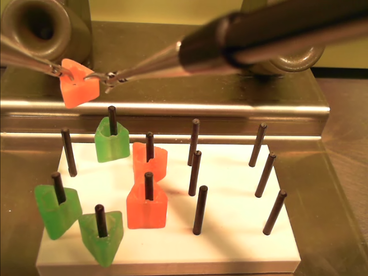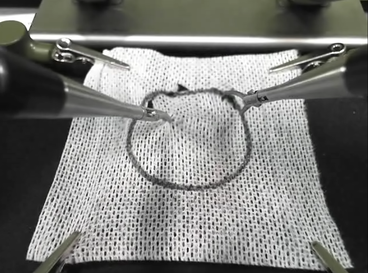


Most automated surgical skill evaluation methods focus predominantly on diagnosis using task-specific maneuvers. These maneuvers require surgical expertise to identify and are observed over the course of a full task. The aim of this investigation is to propose features for automated skill evaluation that are relevant regardless of the surgical training task the tools perform. A secondary aim goal is to diagnose skill without requiring the complete time series of data from a given trial.
We are also investigating the importance of pre-procedural warm-up in surgery via the Robotic Readiness Study.
Our research questions include:
- How do we quantify the technical skills of a training or practicing surgeon?
- What is the relative importance of having tool motion trajectories vs full video data when measuring surgical skill?
- What is it about the dynamics of tool motion that implicates skilled vs non-skilled motions?
- What feedback can most efficiently improve surgical skills?
The current researcher for this project is Jason Kelly.
Relevant Publications:
| [1] | Jason D. Kelly, Ashley Petersen, Thomas S. Lendvay, and Timothy M. Kowalewski. The Effect of Video Playback Speed on Surgeon Technical Skill Perception. International Journal of Computer Assisted Radiology and Surgery, Submitted, 2019. [ .pdf ] |
| [2] | Rodney L. Dockter, Thomas S. Lendvay, Robert M. Sweet, and Timothy M. Kowalewski. The Minimally Acceptable Classification Criterion for Surgical Skill: Intent Vectors and Separability of Raw Motion Data. International Journal of Computer Assisted Radiology and Surgery, 12(7):1151--1159, July 2017. [ DOI | .pdf ] |
| [3] | Anna French, Thomas S Lendvay, Robert M Sweet, and Timothy M Kowalewski. Predicting surgical skill from the first n seconds of a task: Value over task time using the isogony principle. International Journal of Computer Assisted Radiology and Surgery, 12(7):1161--1170, July 2017. [ DOI | .pdf ] |
| [4] | Anna French and Timothy M Kowalewski. Laparoscopic skill classification using the two-third power law and the isogony principle. In 2017 Design of Medical Devices Conference, pages V001T12A001--V001T12A001. American Society of Mechanical Engineers, ASME Digital Collection, 2017. [ .pdf ] |
| [5] | Daniel Holst, Timothy M. Kowalewski, Lee W. White, Timothy C. Brand, Jonathan D. Harper, Mathew D. Sorenson, Sarah Kirsch, and Thomas S. Lendvay. Crowd-sourced assessment of technical skills: An adjunct to urology resident surgical simulation training. Journal of Endourology, 29(5):604--609, 2015. [ DOI | http ] |
| [6] | Thomas S. Lendvay, Timothy M. Kowalewski, Ashleigh Menhadji, Timothy Averch, Geoffrey Box, Timothy Brand, Michael Ferrandino, Jihad Kaouk, Bodo Knudsen, Jaime Landman, Benjamin Lee, Bradley Schwartz, Robert Sweet, and Elspeth McDougall. Validation of laparoscopic training curriculum: The basic laparoscopic urologic skills (blus) initiative. Journal of Urology, American Urological Association Annual Conference Proceedings, 2015. Podium Presentation. |
| [7] | Thomas S Lendvay, Lee White, and Timothy Kowalewski. Crowdsourcing to assess surgical skill. JAMA Surgery: the Journal of the American Medical Association - Surgery, 150(11):1086--1087, 2015. [ .pdf ] |
| [8] | Lee W White, Timothy M Kowalewski, Rodney Lee Dockter, Bryan Comstock, Blake Hannaford, and Thomas S Lendvay. Crowd-sourced assessment of technical skill: A valid method for discriminating basic robotic surgery skills. Journal of Endourology, 29(11):1295--1301, 2015. [ DOI | http ] |
| [9] | Daniel Holst, Lee White, Timothy Brand, Jonathan Harper, and Thomas Lendvay. Crowd-sourced Assessment of Technical Skills: An Adjunct to Urology Resident Surgical Simulation Training. In The Journal of Urology, volume 191, pages e168--. Elsevier, 2014. [ DOI | http ] |
| [10] | Thomas Lendvay, Bryan Comstock, Timothy Averch, Geoffrey Box, Bodo Knudsen, Timothy Brand, Michael Femandino, Johad Kaouk, Jaime Landman, Benjamin Lee, Elpseth McDougall, Ashleigh Mehadji, Bradley Schwartz, Robert Sweet, and Timothy Kowalewski. Crowd-Sourced Assessment of Technical Skills (C-SATS): Validation Through the Basic Laparoscopic Urologic Sugery (BLUS) Curriculum. volume 28, pages A249--A250. Mary Ann Liebert, Inc. 140 Huguenot Street, 3rd Floor New Rochelle, NY 10801 USA, 2014. [ DOI | .pdf ] |
| [11] | Thomas Lendvay, Daniel Holst, Lee White, Timothy Kowalewski, Timothy Brand, Mathew Sorensen, Jonathan Harper, Mireille Truong, Khara Simpson, and Rogher Smith. Differentiating surgical skill through the wisdom of crowds. Number 29, page 77. Engineering and Urology Society, 2014. [ .pdf ] |
| [12] | Thomas S. Lendvay, Lee W. White, Daniel Holst, Timothy Kowalewski, Jonathan D. Harper, Mathew Sorensen, Timothy C. Brand, Mireille Truong, Khara Simpson, and Roger Smith. Quantifying Surgical Skill: Using the Wisdom of Crowds. volume 219, pages e158 -- e159, 2014. Scientific Papers and Scientific Poster Presentations, The American College of Surgeons 2014 Annual Clinical Congress. [ DOI | http ] |
| [13] | Lee W White, Timothy M Kowalewski, Timothy C Brand, Jonathan D Harper, Bryan Comstock, Blake Hannaford, and Thomas S Lendvay. Crowd-Sourced Assessment of Technical Skills: Fast, Economical and Accurate Assessment of Robotic Surgery. In Journal of Urology, volume 191, 2014. [ .pdf ] |
| [14] | Carolyn Chen, Lee White, Timothy Kowalewski, Rajesh Aggarwal, Chris Lintott, Bryan Comstock, Katie Kuksenok, Cecilia Aragon, Daniel Holst, and Thomas Lendvay. Crowd-Sourced Assessment of Technical Skills: a Novel Method to Evaluate Surgical Performance. Journal of Surgical Research, 187(1):65--71, 2013. [ .pdf ] |
| [15] | Thomas S Lendvay, Timothy C Brand, Lee White, Timothy Kowalewski, Saikiran Jonnadula, Laina D Mercer, Derek Khorsand, Justin Andros, Blake Hannaford, and Richard M Satava. Virtual Reality Robotic Surgery Warm-up Improves Task Performance in a Dry Laboratory Environment: A Prospective Randomized Controlled Study. Journal of the American College of Surgeons, 216(6):1181--1192, 2013. [ .pdf ] |